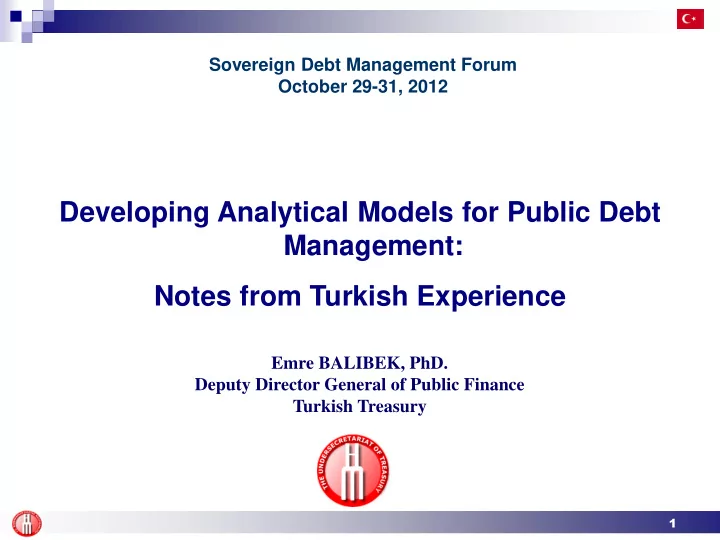

Sovereign Debt Management Forum October 29-31, 2012 Developing Analytical Models for Public Debt Management: Notes from Turkish Experience Emre BALIBEK, PhD. Deputy Director General of Public Finance Turkish Treasury 1
Outline Why an in-house Model? Deterministic vs Stochastic Models Deterministic Model: Stress Testing and Scenario Analyses Stochastic Model: Turkish Debt Simulation Model (TDSM) Use of Models in Decision Making Resources and Challenges in Model Development 2
Why an in-house Model? 3
Why an in-house Model? An off-the-shelf model (commercial software) Theoretically provides Professionalism Efficiency in model implementation Requires low internal support May prove to be Less flexible Restrictive in maintenance and development More expensive (in general) 4
Why an in-house Model? An in-house model Requires institutional capacity Programming skills Software platform IT support Provides Customized solutions (particularly important for a developing country) Independence in terms of development and maintenance Lower cost (in general) 5
Why an In-house Model? A choice between off-the-shelf and in-house models depends on User specific needs Institutional capacity Cost concerns Turkish Treasury chose to develop an in-house model because of its need for flexibility and sophisticated institutional capacity 6
Deterministic vs Stochastic Models 7
Deterministic vs Stochastic Models Deterministic Models Simple Limited number of scenarios May not able to sufficently capture the dynamics of the ‘ system ’ Easy to build, interpret, and communicate Stochastic Models Complex Better replication of the ‘ system ’ Hundreds/thousands scenarios Harder to build, interpret, and communicate 8
Deterministic vs Stochastic Models Not necessarily substitutes for each other Approaches similar in essence Choice should be based on Available resources Degree of detail needed Other country specific circumstances It is also possible to employ deterministic and stochastic models as complementary tools Turkish Case 9
Deterministic Model: Spreadsheet Model Simple MS Excel-based model Used to perform Scenario analyses and stress tests: Financing requirement and debt stock projections under the baseline scenario Effects of changes in macro-fiscal variables Scenarios are built by means of expert judgement, market analysis etc. Accounting approach is also used for debt accumulation 10
Stochastic Model: Turkish Debt Simulation Model (TDSM) Objective Assess the sensitivity of public debt to market movements Help quantify the costs and risks associated with alternative financing strategies: Provide assistance in developing the strategic guidelines 11
Stochastic Model: Turkish Debt Simulation Model Cost-at-Risk Simulation Framework Macroeconomic Scenario Generation Expected cost & risk Debt of alternative Database strategy Cash Flow Alternative Modelling and Borrowing Strategies Requirement 12
Stochastic Model: Turkish Debt Simulation Model Model Building: The Conceptual Model Decision Horizon: 5 years Granularity: quarterly Instruments: A representative selection Choice of Cost and Risk Metrics Choice of Debt Structure Metrics (Key Portfolio Indicators) 13
Stochastic Approach: Turkish Debt Simulation Model TDSM v.1 (2003) Cost Metric: Accrued interest on debt plus changes in debt amortization due to FX rate movements Risk Metric: Cost-at-risk (C@R) at chosen confidence level Platform: MS Visual Basic and Commercial Statistical Softwares 14
Stochastic Approach: Turkish Debt Simulation Model TDSM v.2 (2007) Cost Metrics: Cash-based interest expenditures Level of debt stock Risk Metrics: Conditional cost-at-risk (C@R) Platform: Matlab 15
Stochastic Approach: Turkish Debt Simulation Model TDSM v.2.1 (2010) Modifications based on changing market conditions and instrument set Cost Metrics: Cash-based interest expenditures Level of debt stock Level of inflation adjusted debt stock Risk Metrics: Conditional cost-at-risk (C@R) Platform: Matlab 16
Use of Model in Decision Making 17
Use of Models in Decision Making TDSM results are used to determine strategic benchmarks for debt and risk management Strategic bechmarks aimed at Composition of financing (before 2007) Composition of the debt stock (after 2007) Allows for a holistic appoach to cover Outright sales Buy-backs and debt exchanges Derivative instruments 18
Use of Models in Decision Making Illustrative Results Distribution of Interest Payments Distribution of Debt Stock Projections 300 90 80 250 Frequency Stock/GDP 70 200 Borç Stoku/GSMH (%) 60 CC@R Frekans 150 50 100 40 50 30 0 20 42 44 46 48 50 52 54 2002 2003 2004 2005 2006 2007 2008 2009 2010 2011 2012 Billion TRL Milyar YTL Years 19
Use of Models in Decision Making Illustrative Results Accrued Inflation Adjusted Stock (AIAS) for Interest Payments for Alternative Alternative Strategies Strategies Str-2 Str-1 Interest Payments @ Risk AIAS @ Risk Str-3 Str-4 Str-5 Str-1 Str-2 Str-6 Str-6 Str-5 Str-4 Str-3 Interest Payments AIAS 20
Use of Models in Decision Making Strategic Benchmarks Reduce liquidity / refinancing risk: Maintain a certain level reserve of cash Increase average maturity to the extent that market conditions allow Decrease the share of debt maturing within 12 months Reduce currency risk: Borrow mainly in TL Reduce interest rate risk: Use fixed rate instruments as the major source of domestic borrowing Decrease the share of debt which has interest rate re-fixing period less than 12 months 21
Resources and Challenges in Model Development 22
Resources and Challenges in Model Development Resources Needed Institutional Capacity Committed and Skilled Staff IT systems Financial Resources Training Consulting Software Management Support (probably the most important one) 23
Resources and Challenges in Model Development Challenges In-house modeling Choice of modelling platform Ease of implemention vs.efficiency and speed (Excel vs. some technical computing platform) Capacity building Maintenance Input Modeling Lack of long data series Stationarity problems in data Regime changes Financial crises Distributional assumptions Do scenario generation options enough to cope with extreme cases (event risk)? 24
For more information: Turkish Treasury Simulation Model for Debt Strategy Analysis, World Bank Policy Research Working Paper 6091 25
Recommend
More recommend